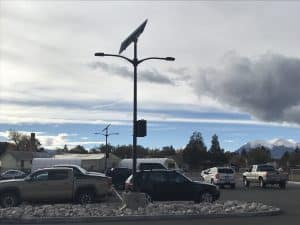How Does Solar Power Lighting Work?Posted by in The Basics.
So perhaps you're in the market for solar power lighting, and you're curious about how it works. You're in luck! Greenshine New Energy has a collection of over 30 years in solar lighting experience, and we're here to give you the details on how this technology has surpassed regular lighting methods. This 5-minute read will give you a brief overview of solar energy, how it works, and how it can solve problems of expensive lighting. How Solar Powered Lighting WorksThe Tech Without the JargonWe'll skip out on the super techy stuff. Solar power is generated directly from the sun's rays striking a thin wafer that's (usually) made from silicon. The silicon is prepared in a vat either by heating it directly (poly-crystalline) or by drawing out a purer silicon ingot (mono-crystalline) through a process called the Czochralski process. Either of these kinds of solar cells (commonly referred to as photovoltaics) is great for use, but mono-crystalline panels are more efficient for solar power lighting. Sunlight strikes the panel and excites electrons in the silicon, thus generating power. The power is stored inside of a lead acid deep-cycle gel battery.
When it comes to the actual light connected to the solar panel, sensors in the light fixture determine when the sun goes down. The light fixture blips on. From a functional standpoint, it's pretty simple. When coupled with an LED fixture that uses minimal energy, there's a win-win since the light fixture draws minimal power and the solar panel power exceeds the drain from the light. It's one of the cleanest, most reliable forms of renewable energy available. Solar power lighting is turning into a standard across the US. That's just the basics of how solar lighting works. There are a lot of newer technologies available right now that are exciting to the world of solar, but they're not really ready for full commercialization yet. For instance, some solar cells are made from perovskite and have higher efficiencies than silicon, but unfortunately, perovskite cells use gold in their construction--we're sure the price point on those cells are pretty high. A lot of similar technologies use a substance called Cadmium which is actually highly toxic and difficult to dispose of. We tend to prefer saving the environment when it comes to using solar technology, so that's why Greenshine adheres to using silicon-based cells. They're the most efficient on the market per dollar since the technology has been well-researched and prepared for mass marketing. Plus, it's a lot more environmentally sound than other lighting and solar technologies. Several lamps carry mercury or similar chemicals that require specific handling for disposal. More Cluck for the BuckOur number-one question on phone calls is: How much does solar power lighting cost? We won't hide the truth--on a per-light basis, solar lights are definitely more expensive. You can expect to pay about 50% more on a solar light as opposed to a sodium-based light. So out-of-pocket, one sodium light will cost about 3 thousand dollars, whereas a solar light will cost 4.5 thousand dollars. However, you'll save long-term, and here's why: Zero Energy BillsSince solar power lighting doesn't pull power from a local power grid, you'll save long-term since you don't receive monthly power bills. But how much? Good question. Here's a breakdown of specific light costs: A High-Pressure Sodium Light running about 4 thousand hours a year will cost you a little more than 400 dollars to operate. Mercury Vapor will cost about the same. A Compact Fluorescent (CFL) light will cost about 6o dollars a year, while a Metal Halide will cost 80 dollars a year, all using the national average of 10.05 cents per kwH. A solar power light will cost you zero annually. It's nice not receiving an energy bill! It's akin to driving a car and not having to pay for gas. Zero Trenching BillsWith traditional lighting, every light needs to be connected to an underground energy grid. To connect each light, you'll need to hire a company to trench. With a standard ten-light system, trenching can add on 30 thousand dollars, easily taking a modest price tag into expensive territory. Trenching for solar power lighting costs zero. We're sure plenty of others prefer paying zero as well. Does Solar Power Lighting Work Anywhere?Remember, solar lights work by pulling light from the sun. Even if the panels are obscured by overcast skies, they'll still develop some power. There are solar panel arrays in Antarctica that are attached to a research facility. These arrays are capable of producing 10% of the facility's power in the middle of the darkest environments on Earth. If that isn't a testament to the power of solar, we aren't sure what is. Greenshine has several thousand installations across the US, some even in rainy and typically overcast areas. It works as long as the lights are positioned to get some sun. Extra BenefitsYou'll never need to worry about power outages since each light operates on its own power and isn't dependent on a central source. If for some reason, the light pole needs to be removed, it's a lot less hassle to lift the light via a crane than trench again for the light and disconnect it from power. Some models of solar power lighting are even movable by forklift or just two people, so if your project requires lights in different spots, rest assured that you can relocate specific models of these lights whenever you need. Plus, sometimes cities and businesses get media attention from going solar. It's not only great for the environment, but it's also a big hit with certain generations. We're happy you could stick around to learn about how solar power lighting works. As the nation's leader in solar lighting, we're prepared to have our engineers huddle together and develop the most cost-effective lighting system for whatever your needs are. Can't afford to trench? Solar is your answer. Need lights that can move at the drop of a hat? We're your go-to. Need some lights to keep your grounds secure? You've got nothing to lose. Contact us to learn more, or check out more technologies of solar panels. The future is shiny, and we've got our sunglasses on.
The Basics
|
ArchivesNo Archives Categories
Want More Info? |
LATEST NEWS & ARTICLES





